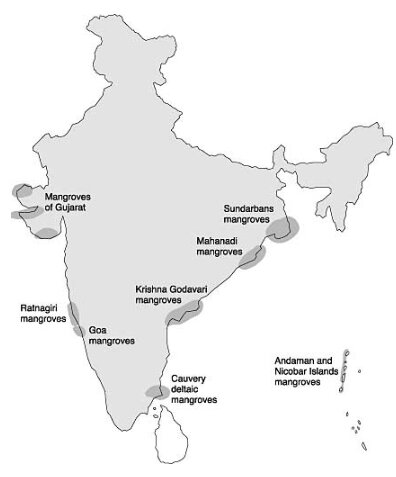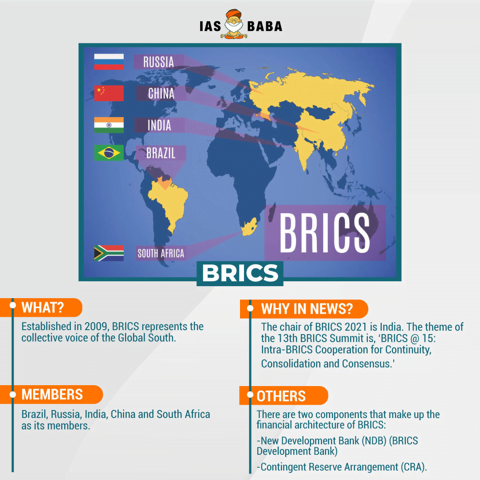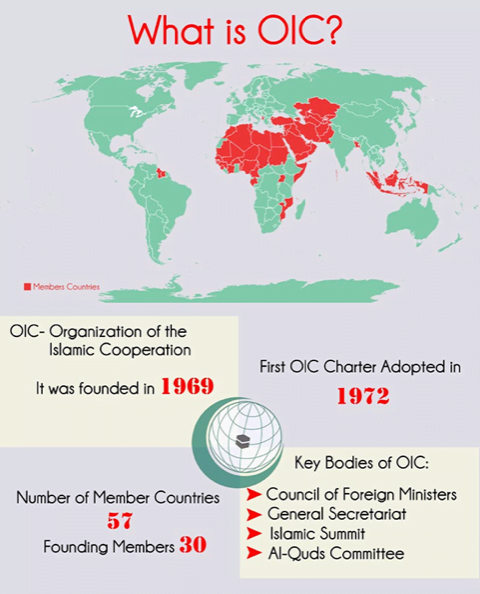IASbaba's Daily Current Affairs Analysis
Archives
(PRELIMS + MAINS FOCUS)
Salt-secreting Mangrove Species
Part of: GS Prelims and GS-III – Biodiversity
In news For the first time a reference-grade whole genome sequence of a highly salt-tolerant and salt-secreting true-mangrove species, Avicennia marina, was reported in India recently.
About Avicennia marina
- Avicennia marina is one of the most prominent mangroves species found in all mangrove formations in India.
- It is a salt-secreting and extraordinarily salt-tolerant mangrove species that grows optimally in 75% seawater and tolerates >250% seawater.
- It is among the rare plant species, which can excrete 40% of the salt through the salt glands in the leaves, besides its extraordinary capacity to exclude salt entry to the roots.
What is the significance of the study?
- This study assumes significance as agriculture productivity globally is affected due to abiotic stress factors such as limited water availability and salinization of soil and water.
- Availability of water is a significant challenge to crop production in dryland areas.
- Salinity is prevalent in ~900 million hectares globally and it is estimated to cause an annual loss of 27 billion USD.
- The genomic resources generated in the study will pave the way for researchers to study the potential of the identified genes for developing drought and salinity tolerant varieties of important crop species of the coastal region that is significant for India.
What are the mangroves?
- Mangroves are a unique group of species found in marshy intertidal estuarine regions and survive a high degree of salinity through several adaptive mechanisms.
- Mangroves are important resources for the coastal region and are of great ecological and economic value such as:
- production of woody trees
- provision of habitat, food, and spawning grounds for fin-fish and shellfish
- provision of habitat for birds and other valuable fauna
- protection of coastlines and accretion of sediment to form new land.
- They form a link between marine and terrestrial ecosystems, protect shorelines, and provide habitat for a diverse array of terrestrial organisms.
- According to the India State of Forest Report, 2017, India has nearly 3.3% of the world’s mangrove vegetation.

News Source: PIB
GIS Enabled Land Bank
Part of: GS Prelims and GS -II – Policies and interventions
In news GIS Enabled Land Bank has been gaining popularity. The website has seen a 30% increase in page views each month since April 2021
What is the Land Bank System?
- The Land Bank system has been developed by the Integration of Industrial Information System (IIS) with state GIS (Geographic Information System).
- IIS portal is a GIS-enabled database of industrial clusters/areas across the states.
- It is a one-stop repository of all industrial infrastructure-related information – connectivity, infra, natural resources & terrain, plot-level information on vacant plots, line of activity, and contact details.
- Currently, the IILB has approximately 4000 industrial parks mapped
- On the system, more than 3,300 industrial parks across 31 states/UTs covering about 4,75,000 hectares of land have also been mapped out.
- The information available on the system will include drainage, forest; raw material heat maps (horticulture, agricultural, mineral layers); multilayer of connectivity.
- IIS has adopted a committed approach towards industrial upgrading, resource optimization, and sustainability.
Who are the Various stakeholders?
- The initiative has been supported by the National e-Governance Division (NeGD), National Centre of Geo-Informatics (NCoG), Invest India, Bhaskaracharya Institute for Space Applications and Geo-Informatics (BISAG), and Ministry of Electronics and Informational Technology.
News Source: PIB
India and Nepal
Part of: GS Prelims and GS-II – International relations
In news Rail Transportation between India & Nepal got a major boost recently.
- Both countries gave authorization to all cargo train operators to utilize the Indian railway network to carry all containers bound for Nepal.
- Letter of Exchange (LoE) between officials of India & Nepal was also signed.
- After this LoE, all kinds of cargoes in all categories of wagons that can carry freight on Indian Railways network within India can also carry freight to and from Nepal
Benefits of the LoE
- This liberalization will allow market forces to come up in the rail freight segment in Nepal.
- Likely to increase efficiency and cost- competitiveness, eventually benefiting the Nepalese consumers.
- Move will reduce transportation costs for automobiles and certain other products whose carriage takes place in special wagons.
- Another milestone in India’s efforts to enhance regional connectivity under the “Neighbourhood First” policy.
Do you know?
- The Central government on 21 September 2016 approved merger of the Rail and General budgets from 2017, ending a 92-year-old practice of a separate budget for the Railways.
- The decision to merge both the budgets was based on the recommendations of the committee chaired by Member of NITI Aayog, Bibek Debroy.
News Source: PIB
BRICS
Part of: GS Prelims and GS -II – International relations
In news All BRICS countries have agreed to the STI-led BRICS Innovation Cooperation Action Plan (2021-24) proposed by India during the 12th Meeting of BRICS S&T Steering Committee.
- Indian had proposed the plan to facilitate sharing of experiences of each other’s innovation ecosystem and networking of innovators and entrepreneurs.
About BRICS
- BRICS is an acronym for the grouping of the world’s leading emerging economies, namely Brazil, Russia, India, China and South Africa.
- The BRICS Leaders’ Summit is convened annually.
- BRICS does not exist in the form of organization, but it is an annual summit.
- The Chairmanship of the forum is rotated annually among the members, in accordance with the acronym B-R-I-C-S.
-
- Together, BRICS accounts for about 40% of the world’s population and about 30% of the GDP (Gross Domestic Product), making it a critical economic engine.
- It’s an emerging investment market and global power bloc
- Objectives:
-
- The BRICS seeks to deepen, broaden and intensify cooperation within the grouping and among the individual countries for more sustainable, equitable and mutually beneficial development.
- BRICS takes into consideration each member’s growth, development and poverty objectives to ensure relations are built on the respective country’s economic strengths and to avoid competition where possible.
- BRICS is emerging as a new and promising political-diplomatic entity with diverse objectives, far beyond the original objective of reforming global financial institutions.
What are the components of financial architecture of the BRICS?
-
- NDB is headquartered in Shanghai.
- During the Sixth BRICS Summit in Fortaleza (2014) the leaders signed the Agreement establishing the New Development Bank (NDB).
- NDB’s key areas of operation are clean energy, transport infrastructure, irrigation, sustainable urban development and economic cooperation among the member countries.
-
- Considering the increasing instances of global financial crisis, BRICS nations signed BRICS Contingent Reserve Arrangement (CRA) in 2014 as part of Fortaleza Declaration at Sixth BRICS summit.
- The BRICS CRA aims to provide short-term liquidity support to the members through currency swaps to help mitigating BOP crisis situation and further strengthen financial stability.
- The initial total committed resources of the CRA shall be one hundred billion dollars

News Source: PIB
Methane in the Moons of Saturn
Part of: GS Prelims and GS -III – Space
In news NASA’s Cassini spacecraft had detected an unusually high concentration of methane, along with carbon dioxide and dihydrogen, in the moons (Titan and Enceladus) of Saturn by flying through their plumes (in 2017).
- It found that Titan has methane in its atmosphere and Enceladus has a liquid ocean with erupting plumes of gas and water.
- An international research team has used new statistical methods to understand if methanogenesis or methane production by microbes could explain the molecular hydrogen and methane.
What are the Findings of Cassini?
- Cassini found ice particles, salts, hydrogen and organic molecules in the plumes, tentative hints of an ocean that is similar to Earth’s oceans in composition.
- There is also evidence for alkaline hydrothermal vents on Enceladus’ seafloor, similar to those that support methanogens in Earth’s oceans.
What are Methanogens?
- Most of the methane on Earth has a biological origin.
- Microorganisms called methanogens are capable of generating methane as a metabolic byproduct.
- They do not require oxygen to live and are widely distributed in nature.
- They are found in swamps, dead organic matter, and even in the human gut.
- They are known to survive in high temperatures and simulation studies have shown that they can live in Martian conditions.
- Methanogens have been widely studied to understand if they can be a contributor to global warming.
- Possibility of Methanogens on Enceladus:
- Methane could be formed by the chemical breakdown of organic matter present in Enceladus’ core.
- Hydrothermal processes could help the formation of carbon dioxide and methane.
- Enceladus’ hydrothermal vents could be habitable to Earth-like microorganisms (Methanogens).
- Few missions have visited Saturn: Pioneer 11 and Voyagers 1 and 2 flew by; But Cassini orbited Saturn 294 times from 2004 to 2017.
News Source: IE
Zika Virus Disease
Part of: GS Prelims and GS II – health
In news Recently, Zika Virus Disease (ZVD) was reported for the first time in Kerala.
What is a Zika Virus?
- Zika virus is a mosquito-borne flavivirus that was first identified in Uganda in 1947 in monkeys.
- It was later identified in humans in 1952 in Uganda and the United Republic of Tanzania.
- ZVD is caused by a virus transmitted primarily by Aedes mosquitoes (AM), mainly Aedes aegypti.
- This is the same mosquito that transmits dengue, chikungunya and yellow fever.
- Transmission: From mother to fetus during pregnancy, through sexual contact, transfusion of blood and blood products, and organ transplantation.
- Symptoms:
- Fever, rash, conjunctivitis, muscle and joint pain, malaise or headache.
- Most people with Zika virus infection do not develop symptoms.
- Zika virus infection during pregnancy can cause infants to be born with microcephaly (smaller than normal head size) and other congenital malformations, known as congenital Zika syndrome.
- Treatment:
- There is no vaccine or medicine for Zika.
- The focus is on relieving symptoms and includes rest, rehydration and acetaminophen for fever and pain.
Related Indian Government Programme/Initiatives
- Integrated Disease Surveillance Programme: To strengthen/maintain decentralized laboratory based and IT enabled disease surveillance systems for epidemic prone diseases to monitor disease trends.
- National Vector Borne Disease Control Programme: The central nodal agency for prevention and control of six vector borne diseases i.e. Malaria, Dengue, Lymphatic Filariasis, Kala-azar, Japanese Encephalitis and Chikungunya in India.
- Rashtriya Bal Swasthya Karyakram (RBSK): An initiative under the National Health Mission, has a surveillance for Microcephaly (system for monitoring birth defects).
News Source: IE
India Rejects OIC’s Proposal
Part of: GS Prelims and GS – II -International relations
In news Recently, the Ministry of External Affairs rejected the Organisation of Islamic Cooperation’s (OIC) proposal to assist a dialogue between India and Pakistan.
What was OIC’s Offer?
- OIC offered to arrange a meeting between India and Pakistan and proposed to send a delegation to Jammu & Kashmir
- Pakistan has repeatedly sought to raise the Kashmir issue at the OIC
What was India’s Response?
- The OIC should be watchful that their platform is not subverted by “vested interests” such as Pakistan to interfere in internal affairs of India or for anti-India propaganda through biased and one-sided resolutions.
What is Organisation of Islamic Cooperation?
- It is the second largest intergovernmental organization after the United Nations (UN) with a membership of 57 states.
- It is the collective voice of the Muslim world.
- It endeavours to safeguard and protect the interests of the Muslim world in the spirit of promoting international peace and harmony among various people of the world.
- India is not a member of the OIC.
- It was established upon a decision of the historical summit which took place in Rabat, Kingdom of Morocco in September 1969.
- Headquarters: Jeddah, Saudi Arabia.

News Source: TH
(Mains Focus)
GOVERNANCE/ RIGHTS
Topic:
- GS-2: Government policies and interventions for development in various sectors and issues arising out of their design and implementation
- GS-2: Rights and Freedoms
Amendments to Cinematograph Act
Key features of Draft Cinematograph (Amendment) Bill 2021
- Age-based certification: It proposes to divide the existing categories (U, U/A and A) into further age-based groups: U/A 7+, U/A 13+ and U/A 16+.
- Provision against piracy: At present, there are no enabling provisions in Cinematography Act to check film piracy. The draft bill includes penal provision for piracy.
- Validity of Certificate: It proposes to certify films for perpetuity. Currently a certificate issued by the CBFC is valid only for 10 years.
- Revisional powers of the Union Govt.: It empowers Union government to order a ‘re-examination’ of an already certified film if there are complaints against it.
Concerns
- Government as Super Censor: Revisional powers of Union govt. will effectively make it supreme power over cinema exhibition in the country
- Freedom of Speech: The encroachment of the central government on creative independence, in mandating what films can be produced and consumed, potentially endangering freedom of expression and weakens the scope of a mature democracy.
- Increasing Regulatory role of Govt.: The Cinematograph (Amendment Bill) 2021, subsequent restrictions on OTT platforms and the abolishment of the FCAT only add further fuel to the fire.
- Not a broken system: The Central Board of Film Certification (CBFC) has a robust mechanism for film certification and there is no need to fix something that is not broken.
- Public Consultation: The government has not provided enough time (only 14 days) for meaningful consultation and the proposed changes ignore suggestions of reports by two committees of experts on CBFC reform.
Conclusion
The global cinematic trend seems to be moving close to meaningful, nuanced cinema and series, beyond the purview of sanitised and glamorised big Hollywood and Bollywood blockbusters. We might be taking a step or two backward now with such rules.
Connecting the dots:
JUDICIARY/ GOVERNANCE
Topic:
- GS-2: Judiciary
Judicial Appointment System
Collegium System
- In Second Judges case, 1992, SC held that the Collegium’s (CJI and the four senior-most judges of the SC) recommendations to President for appointment of Judges to HC & SC are binding in nature.
- Supreme Court has re-interpreted Article 124 and 214 of the Constitution & upheld Collegium system so as to secure Independence of Judiciary & the rule of law.
- SC even struck down National Judicial Appointments Commission (NJAC) as it strongly disapproved of any role for the political executive in the appointment of judges, saying, “reciprocity and feelings of payback to the political executive” would be disastrous to the independence of the judiciary.
Procedure for Various Judicial Appointments:
For CJI:
- In practice, it has been strictly by seniority ever since the supersession controversy of the 1970s.
- President appoints CJI.
For SC Judges:
- The proposal is initiated by the CJI.
- The CJI consults the rest of the Collegium members, as well as the senior-most judge of the court hailing from the High Court to which the recommended person belongs.
- The consultees must record their opinions in writing and it should form part of the file.
- The Collegium sends the recommendation to the Law Minister, who forwards it to the Prime Minister to advise the President (recommendations of Collegium is binding)
Criticism of Collegium System
- Opaqueness and a lack of transparency.
- Scope for nepotism.
- There are allegations that candidates lacking in essential attributes have been appointed routinely.
- It is dilution of doctrine of checks & balances (for ex: In USA, President appoints Judges of Supreme Court)
Conclusion
There is a heavy burden on shoulders of Judges of Collegium. One can only hope and pray that they will discharge it in consonance with constitutional oath & dispel any criticism against it.
About National Judicial Appointments Commission (NJAC)
- NJAC was envisaged as body to replace Collegium system to make appointments to higher Judiciary
- It was established by 99th Constitutional Amendment Act, 2014 but was struck down by SC as unconstitutional
- NJAC was to consist of the following members:
- Chief Justice of India (Chairperson, ex officio)
- Two other senior judges of the Supreme Court next to the Chief Justice of India – ex officio
- Union Minister of Law – ex-officio
- Two eminent persons (to be nominated by a committee consisting of CJI, PM and the Leader of Opposition or leader of single largest opposition party in the Lok Sabha)
Connecting the dots:
(TEST YOUR KNOWLEDGE)
Model questions: (You can now post your answers in comment section)
Note:
- Correct answers of today’s questions will be provided in next day’s DNA section. Kindly refer to it and update your answers.
- Comments Up-voted by IASbaba are also the “correct answers”.
Q.1 Consider the following statements regarding Organisation of Islamic Cooperation:
- It is the second largest intergovernmental organization after the United Nations (UN)
- India is the founding member of OIC
Select the correct statements
- 1 Only
- 2 Only
- Both 1 and 2
- Neither 1 nor 2
Q.2 Consider the following statements regarding Methanogens
- They do not require oxygen to live.
- They are found in swamps, dead organic matter, and even in the human gut.
Select the correct statements
- 1 Only
- 2 Only
- Both 1 and 2
- Neither 1 nor 2
Q.3 Which of the following disease is not caused by Aedes mosquitoes?
- ZIka virus
- Chickengunya
- Yellow fever
- Malaria
ANSWERS FOR 9th July 2021 TEST YOUR KNOWLEDGE (TYK)
| 1 | A |
| 2 | D |
| 3 | D |
Must Read
On Arbitration:
On School Enrolment:














